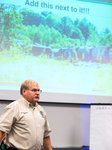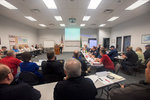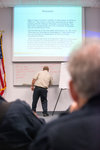


Personnel from multiple law enforcement and emergency response agencies on Wednesday teamed up with officials with Burlington Northern Santa Fe Railway and Amtrak to consider what would happen in the case of a dangerous emergency train derailment.
In the proposed scenario, a freight train possibly transporting hazardous materials and an Amtrak train derailed near the Southwest Washington Fairgrounds.
One of the Amtrak cars is overturned with no road access to it.
About 30 participants at the BNSF-sponsored discussion and exercise called “No Road to Extrication” talked about communication, coordination and response to the hypothetical incident.
Lewis County Sheriff Steve Mansfield said the exercise was a good start in considering a mass casualty and hazardous material situation involving the railway companies.
Mansfield said with community concerns about oil being shipped by rail through Chehalis and Centralia, area agencies need to be ready to respond if an incident happens.
Just this year, there were four minor derailments on the rail owned by Puget Sound and Pacific between Centralia and Grays Harbor.
Mansfield said working with BNSF and Amtrak showed that the companies take the possibility of an emergency event seriously, and that they helped law enforcement officials and emergency responders understand the companies’ roles and responsibilities.
The general consensus among participants was that if all the agencies know what is going on and coordinate, responding to a situation will be easier.
Rictor Overlie, a footboard yardmaster with BNSF, facilitated the discussion.
After Overlie outlined the scenario, the participants shared what their concerns were in the incident, such as patient transportation, scene access, condition of crews from trains, other trains scheduled to travel through the area, incident command and detouring vehicle traffic.
Overlie said the most challenging aspect of the scenario presented to local agencies is access to the scene — to get crews in and victims out.
In this particular scenario, participants discussed how close they could get to the scene and the likelihood of carrying victims to a staging area. Utilizing school district buses as a way to transport people was considered as well.
Overlie said the scenario is designed to be realistic and feasible, and because similar incident occur infrequently, it can seem catastrophic.
While the Federal Railroad Administration and the Occupational Safety and Health Administration require the discussion as well as hands-on training of scenarios, Overlie wants the trainings to be more than checking off that agencies completed them.
He wants the participants to know what to do if something should happen, he said.
“The more everyone is prepared, the less impact there is,” he said.
Some questions, such as what the best access point was, remained unanswered at the end of the discussion because the scenario didn’t specify specifics such as the number of Amtrak passengers and crew, weather conditions and how much hazardous material spilled.
But even with some specifics about the response still in question, Mansfield said the group covered a lot of information and accomplished what they intended to cover. He said if the scenario did specify the missing variables, the first responders would have been able to say exactly how everything would be managed.
Riverside Fire Authority Chief Mike Kytta agreed that the session was productive, and having railway industry representatives participate was a critical learning opportunity for area responders, he said.
Along with railway, law, fire and emergency medical service representatives, officials with the fairgrounds, American Red Cross, Lewis County Public Works and the Emergency Operations Center participated in the session.
Kytta said all the entities are cooperating and are interested in solutions for a common goal.
“Part of doing the exercise … is to evaluate areas to find out how prepared we are,” he said.
While the area agencies have limited resources, Kytta said being small isn’t a bad thing because the responders know one another, which is a strength.
He said the crews have good plans and are well-trained. Testing those assets in the field with a hands-on, full-scale exercise would be a “great next step,” he said.